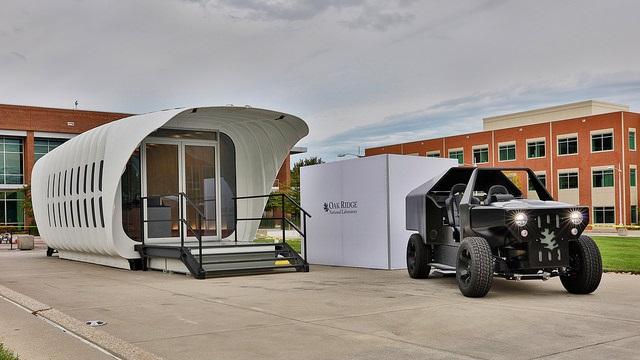
The construction and demonstration of the Additive Manufacturing + Integrated Energy (AMIE) project was a unique opportunity to showcase Oak Ridge National Laboratory expertise and collaboration in many areas, including 3D printing and vehicle and residential technologies. The contributions of the Electrical and Electronics Systems Research (EESR) Division—wireless charging, energy transfer, secondary battery energy storage, and advanced sensors and controls, to name a few—were essential to the project’s innovative functionality. The technology demonstrated is being advanced and scaled to other projects as well.
AMIE demonstrates a future in which a home equipped with its own power generation—in this case, a 3.2 kilowatt solar panel system—can produce, store, and consume renewable energy. The 3-D-printed house’s energy system can wirelessly charge a hybrid electric vehicle, and that vehicle can, in turn, supplement power to the house as needed.
A home and vehicle that can produce and store electricity and transfer that power back and forth provide key benefits: the home’s occupants can still have electricity during outages, and there is less stress on the aging utility grid if the home can use its own power during periods of peak demand.
To contribute to AMIE, EESR staff developed breakthroughs in several areas, not the least of which is the ability to wirelessly transfer a large amount of power—up to 6.6 kilowatts—in two directions.
Bidirectional Wireless Power Transfer
AMIE serves as a research platform to evaluate algorithms that can govern how energy is shared among available resources, anticipate when power is available from the sun, and determine when electricity is needed in the building.
These algorithms, which function like AMIE’s “brain,” subsequently control how to shift building loads (such as the heating, ventilation, and air-conditioning system [HVAC]) and provide the remaining energy needs with an optimal balance of power generation from the vehicle and from the electric grid. The brain also coordinates with algorithms in the end devices, such as the car and the HVAC, to ensure optimized power use in AMIE’s individual components.
Routing electricity from the car to power the house is a novel approach.
“AMIE is the first demonstration of bidirectional wireless power transfer at this level [6.6 kilowatts] in the world,” said Burak Ozpineci, group leader of ORNL’s Power Electronics and Electric Machinery Research Group. “We’ve been working on wireless power transfer at this power level for about 7 years but didn’t start making it bidirectional until midsummer last year while AMIE was being developed.”
AMIE’s 3-D-printed utility vehicle (PUV) runs on natural gas that is stored in two fuel tanks and powers the vehicle’s generator. Energy flows from the generator to the battery to the electric motor; when the PUV is parked, the coils align and the generator sends energy to a wireless charging pad on the ground. The charging pad sends electricity to the building to power the loads or charge the battery, which stores and supplies energy to the home. When the battery is fully charged, it can power both the house and car.
The groundbreaking work on the wireless power transfer system netted the PEEM researchers a Distinguished Achievement Award as part of the US Department of Energy’s Annual Merit Review. The DOE Vehicle Technologies Office honored the team for developing and demonstrating the world’s first high-power wireless charging system for passenger cars. The technology achieves 90% efficiency at three times the rate of the plug-in systems commonly used for electric vehicles today.
“We will have an electric car future, so why not make our electric vehicles work while they’re parked?” Ozpineci said. “If the power goes out, power generated wirelessly by the vehicle can automatically power the house.”
Taking an even broader view of the future, Ozpineci envisions large parking lots in urban areas equipped with charging stations that, through bidirectional wired or wireless power transfer, allow people to recharge their electric vehicles as well as provide emergency power to nearby buildings.
Storing energy with repurposed vehicle batteries
Tasked with developing a system for storing energy at the house, EESR researchers employed another novel solution to save money: repurposing batteries from electric vehicles.
“We’re essentially looking at how energy storage can help a project like AMIE, and larger communities of residential homes, at a very low cost,” said Michael Starke, a researcher in EESR’s Power and Energy Systems (PES) Group. “You’re not paying for a new battery pack, but you’re still getting a battery pack that has a lot of life left.”
For AMIE, the batteries came from a Fiat electric vehicle donated by Spiers New Technologies. The challenge then was for ORNL researchers to design a slim, low-profile, and safe energy storage system that would fit underneath the home’s stairs.
“We designed a sealed container to keep the lithium-ion batteries dry and to protect from short-circuiting, and we implemented a roller to roll the battery rack in and out of place under the stairs,” Starke said.
“Implementing a secondary-use battery system was a huge first step in my PhD dissertation topic. My project includes using different chemistries of secondary-use batteries to create a large-scale energy storage system,” said Mitchell Smith, a Bredesen Center graduate student working with the PES Group.
To make the system safe to handle without heavy protective gear, Starke and his fellow researchers also broke up the 400-volt battery package into 50-volt segments. “Since we have these fuses, we can open it up and get our hands on it. Otherwise we would have to wear a lot of protective equipment,” said Starke, who is the principal investigator on both the secondary battery storage system and the power management system for AMIE.
Another aspect of the battery storage system is that it is designed to handle an unbalanced power flow. Bailu Xiao, the research lead for controls development, noted, “we developed a new type of inverter control to deal with problems unique to split phase systems.” In a typical split phase house, you have two power flows—one positive and one negative—and when you operate as usual with a single inverter and no middle tap, power flow has to be equal. But AMIE has a different configuration that allows the house to have unbalanced flows, which is an advantage in controlling and directing the power load of the house and in connecting it to the larger utility grid.
Automated building energy management system
AMIE’s various energy systems required a sophisticated control system, and that’s where the PES Group’s work on microgrid controllers proved essential.
A microgrid is a local energy system that can operate independently of a utility grid, supported by an onsite power source such as photovoltaics (PVs), batteries, distributed generation, or other resources. That onsite generation can be fed into the larger utility grid, or it can be disconnected and power the local site in events such as storms or a larger grid failure. For the past year, ORNL researchers have been working on a controller for microgrids that measures and controls onsite power sources and determines how and when to transfer that electricity.
“For AMIE, we leveraged that research and development to run the house,” Starke said. “Communications, integration, all that we learned was pulled down to AMIE—which we’ve essentially been calling a nanogrid as it’s smaller than a typical microgrid.”
One of the challenges for the PES Group with AMIE was the varied types of devices that needed to be integrated.
“We’re interfacing PVs, energy storage, we’re interfacing metering so we can get data from that, we’re interfacing the HVAC for controls, and between all those different devices, there’s not a single communication that is exactly the same,” Starke noted. “They all have different protocols, different data sets and measurements, and the goal is to optimize all those assets. You have to coordinate and link them all together so that you have an optimization strategy for the house. “
Fellow project member Dan King, added “We have created a system approach that brings all of the operations of building management, energy management, visualization, optimization, data logging, and device controls; all the things you need to make the elements function as a single system.”
Typical control is focused on a master device or system that issues all commands and coordination. In this case, the system devices can intercommunicate without directly interfacing.
Drew Herron, another member of the team, stated “the communication methodology adopted for the AMIE project establishes communications with the master controller and also between devices. This provides the devices the ability to interact with each other more rapidly than only through a centralized application.”
For instance, Starke said, researchers can plug in the rate structure of the local utility to the system and then be able to show that the house is making money using its own energy system and/or feeding power to the utility grid.
In addition to working on AMIE’s own structures, the researchers have also used ORNL’s Distributed Energy Communications and Controls (DECC) Lab. “The DECC Lab has almost the same setup as AMIE,” Starke said, “with HVAC, PV on the rooftop, and the same type of metering technology.”
While the researchers continue to refine AMIE’s controls and systems, they will soon demonstrate the secondary battery storage and controller technology in a residential community. Plans are on tap for a similar system to be deployed with several partners at a site in the Southeast U.S. The PES Group is currently working on an economic model to size a repurposed battery pack for one of the community’s homes and is expected to install the battery storage unit sometime in the fall of 2016.
“We’re essentially studying how energy storage and controls can help communities lower costs and provide reliable power service at the same time,” Starke said. “That’s one of the key things AMIE demonstrates.”
Other PES Group researchers who worked on these aspects of AMIE include Drew Herron, Philip Irminger, Daniel King, T. Ben Ollis, Mitchell Smith, and Bailu Xiao. Researchers in the PEEM Group include Steven Campbell, Paul Chambon, Madhu Chinthavali, Suman Debnath, Omer Onar, Burak Ozpineci, Larry Seiber, Lixin Tang, Cliff White, and Randy Wiles.
The AMIE demonstration project was developed by multiple research teams at ORNL and many industry partners and was sponsored by three offices under DOE’s Office of Energy Efficiency and Renewable Energy: the Building Technologies Office, Advanced Manufacturing Office, and Vehicle Technologies Office. --by Stephanie Seay, Sara Shoemaker



